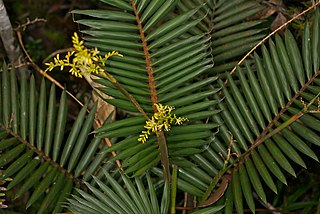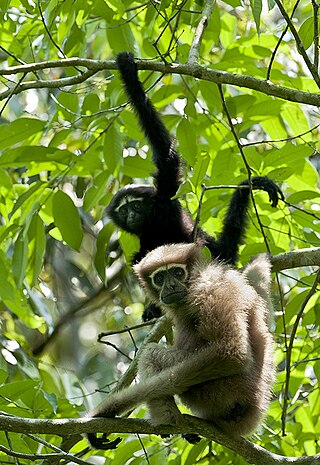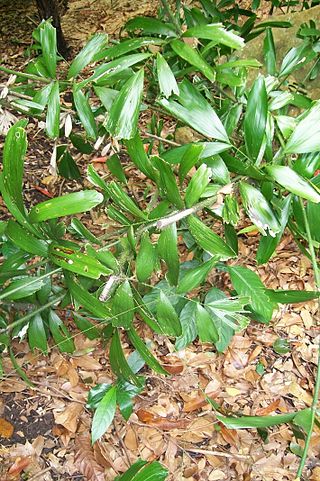
Calamus is a small town in Clinton County, Iowa, United States, located on the historical Lincoln Highway, which was the first transcontinental highway for automobiles across the U.S.. Calamus is the only town in Olive Township and had a population of 356 at the 2020 census, which was a 9.6% decrease from 2000. Calamus was named after Calamus Creek, which received its name from the great quantities of sweet flag growing in it, derived from the botanical name Acorus calamus, commonly called Sweet Flag or Calamus.

Acorus is a genus of monocot flowering plants. This genus was once placed within the family Araceae (aroids), but more recent classifications place it in its own family Acoraceae and order Acorales, of which it is the sole genus of the oldest surviving line of monocots. Some older studies indicated that it was placed in a lineage, that also includes aroids (Araceae), Tofieldiaceae, and several families of aquatic monocots. However, modern phylogenetic studies demonstrate that Acorus is sister to all other monocots. Common names include calamus and sweet flag.

Acorus calamus is a species of flowering plant with psychoactive chemicals. It is a tall wetland monocot of the family Acoraceae, in the genus Acorus. Although used in traditional medicine over centuries to treat digestive disorders and pain, there is no clinical evidence for its safety or efficacy – and ingested calamus may be toxic – leading to its commercial ban in the United States.

Calamus is a genus of flowering plants in the palm family Arecaceae that is one of several genera known as rattan palms. There are an estimated 400 species in this genus, all native to tropical and subtropical Asia, Africa, and Australia.
The "Calamus" poems are a cluster of poems in Leaves of Grass by Walt Whitman. These poems celebrate and promote "the manly love of comrades". Most critics believe that these poems are Whitman's clearest expressions in print of his ideas about homoerotic male love.
Kalamos is a Greek mythological figure. He is son of Maiandros, the god of the Maeander river.

Acorus americanus, the American sweet flag, is an emergent wetland plant native to the northern United States and Canada. This perennial plant has bright green blade-shaped leaves that arise directly from the rhizomes and sheath into each other at the base. Additionally the blades have 2-6 raised veins, and a swollen center when viewed in cross section. The foliage has a citrus-like spicy aromatic quality, and can be used to flavor beer. It is a flowering plant with inconspicuous flowers that are arranged on a lateral spadix and the fertilized flowers produce berries with a jelly inside. This plant is protected as a state endangered species in Pennsylvania.

The Palmetum is a specialized botanical garden located in the Malakpet area, Hyderabad, in Telangana, which features only one family of plant: the palms.

The Hollongapar Gibbon Sanctuary, formerly known as the Gibbon Wildlife Sanctuary or Hollongapar Reserved Forest, is an isolated protected area of evergreen forest located in Assam, India. The sanctuary was officially constituted and renamed in 1997. Set aside initially in 1881, its forests used to extend to the foothills of the Patkai mountain range.

Calameae is a palm tree tribe in the subfamily Calamoideae. The type genus is Calamus and many of its members are rattans.

Calamus rotang, also known as common rattan, is a plant species native to India, Sri Lanka and Myanmar (Burma). It is one of the scandent (climbing) rattan palms used to make Malacca cane furniture, baskets, walking-sticks, umbrellas, tables and general wickerwork, and is found in Southwest Asia. The basal section of the plant grows vertically for 10 metres or so, after which the slender, tough stem of a few centimetres in diameter, grows horizontally for 200 metres or more. It is extremely flexible and uniform in thickness, and frequently has sheaths and petioles armed with backward-facing spines which enable it to scramble over other plants. It has pinnate, alternate leaves, 60–80 cm long, armed with two rows of spines on the upper face.

Calamus australis, commonly known as wait-a-while, hairy mary or lawyer cane, is a plant in the palm family Arecaceae which is endemic to the rainforests of north east Queensland, Australia. Like other species in the genus Calamus, this is a climbing plant with a very long and flexible stem. It uses sharp strong hooks on the fronds and tendrils to attach itself to other vegetation, such as taller established trees, thus gaining support that enables it to grow higher towards the canopy. This species is very similar to C. radicalis, with which it coexists, but is smaller in almost all respects.

Calamus caryotoides, more commonly known as fishtail lawyer cane is a North-East Queensland tropical forest climbing palm with very thin flexible trunks; no crownshaft; small spikes; dark green, glossy, fish-tail shaped leaves reaching up to 15 m (50 ft) high ; and very thin hooked flagella.

Calamus muelleri, commonly known as southern lawyer cane or wait-a-while, is a climbing palm with a vine-like habit, endemic to the subtropical coastal rainforests of northern New South Wales and southern Queensland. Sharp hooks on the plant can snag the clothing of walkers in these forests, giving rise to the name "wait-a-while".
Calamus nambariensis is a species of flowering plant in the family Arecaceae. It is found in Burma, Laos, Vietnam, Thailand, Nepal, Bhutan, Bangladesh, the Assam region of India and the Yunnan region of China.
Calamus bousigonii, is a liana, a climbing plant, and part of the Arecaceae, or palm, family. It is a member of the subfamily Calamoideae, whose members are usually called rattans in English,
Calamus erectus, also known as viagra palm and locally as tynriew, tara, and zhi li sheng teng, is a flowering shrub in the family Arecaceae. The specific epithet (erectus) refers to the plant's habit of growing straight rather than creeping or climbing like many species of the genus Calamus.

Calamus draco is an Asian species of rattan plant in the family Arecaceae; its native range is from peninsular Thailand to western Malesia. It is a source of the red resin known as dragon's blood, which is a pigment with medicinal uses.

Calamus vitiensis, commonly known as the Dunk Island lawyer vine, solitary lawyer vine or Mission Beach wait-a-while, is a climbing palm in the family Arecaceae. It grows in rainforests from the Maluku Islands east through New Guinea and the Solomon Islands to Fiji and Vanuatu, and south to Queensland, Australia.














